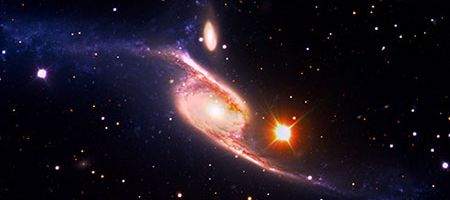Astronomers have established that the spectacular barred spiral galaxy NGC 6872 – first discovered decades ago – is the largest-known spiral galaxy.

Using archival data from NASA’s Galaxy Evolution Explorer (GALEX) mission, the team’s calculated that it measures more than 522,000 light-years across, making it more than five times the size of our Milky Way galaxy. It’s located 212 million light-years from Earth in the southern constellation Pavo.
“Without GALEX’s ability to detect the ultraviolet light of the youngest, hottest stars, we would never have recognized the full extent of this intriguing system,” says Rafael Eufrasio, a research assistant at NASA’s Goddard Space Flight Center.
The galaxy appears to have reached this size by swallowing up a much smaller disk galaxy, IC 4970, which has only about one-fifth its mass. However, it doesn’t appear to be digesting it very well, and the astronomers suspect that the merger may be spawning a new small galaxy.
“The northeastern arm of NGC 6872 is the most disturbed and is rippling with star formation, but at its far end, visible only in the ultraviolet, is an object that appears to be a tidal dwarf galaxy similar to those seen in other interacting systems,” says Duilia de Mello, a professor of astronomy at Catholic University.
By analyzing the distribution of energy by wavelength, the team uncovered a distinct pattern of stellar age along the galaxy’s two prominent spiral arms. The youngest stars appear in the far end of the northwestern arm, getting progressively older toward the galaxy’s center.
The southwestern arm displays the same pattern, which is likely connected to waves of star formation triggered by the galactic encounter.
Like all barred spirals, NGC 6872 contains a stellar bar between the spiral arms and the galaxy’s central regions, measuring about 26,000 light-years in radius. The team found no sign of recent star formation along the bar, which indicates it formed at least a few billion years ago.
“Understanding the structure and dynamics of nearby interacting systems like this one brings us a step closer to placing these events into their proper cosmological context, paving the way to decoding what we find in younger, more distant systems,” says Goddard astrophysicist Eli Dwek.






